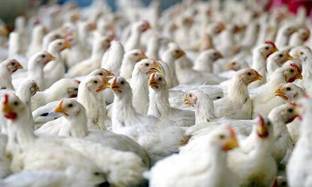
Egg drop syndrome (EDS) - A viral infection in laying hens
Egg drop syndrome (EDS) is caused by a viral infection in laying hens. It is characterised by production of soft-shelled and shell-less eggs in apparently healthy birds, and leads to a sudden drop (10-40%) in recorded egg production or a failure to achieve a normal peak in production. It can be difficult to identify the early stages of the disease as hens will eat the shell-less eggs, and the only evidence that may remain is the membranes, which is a sign that is easy to miss. In flocks where some birds have acquired immunity due to the spread of the virus, a failure to reach expected production targets is observed. Clinical signs include diarrhoea and brief loss of shell colour and egg yolk pigment prior to the production of soft-shelled eggs and mortality is usually negligible. Ducks and geese are the natural hosts for the EDS virus and are asymptomatic carriers. Chickens of all ages and breeds are susceptible but the disease is most severe in broiler breeders and brown-egg layer strains. EDS was first introduced into chickens through contaminated vaccine and spread through breeder flocks. EDS is a notifiable disease in some states of Australia.
EDS can be distinguished from Newcastle disease and influenza virus infections by the absence of illness, and from infectious bronchitis by the eggshell changes that occur at or just before the drop in egg production.
EDS is caused by infection with the EDS virus which is an adenovirus. The incubation period is three to five days and the course of the disease is four to 10 weeks. The virus is transmitted through any of the conventional means of viral disease spread and is also transmitted on and in the egg (horizontal and vertical transmission). The main method of horizontal spread is through contaminated egg trays, however, droppings are also infective. Contact with wild ducks or geese, or water or ranges frequented by these birds, may be a source of infection. Humans and contaminated fomites (such as crates or trucks) can spread virus, which can also be transmitted by needles when vaccinating and drawing blood. Insect transmission has not been proven but is considered possible. Chicks hatched from infected eggs may develop antibodies and excrete virus however it is more common that the virus will remain latent (alive but inactive) and subsequently the bird will not produce antibodies. The virus reactivates and grows in the oviduct when the hens go into lay, at which point the viral cycle begins again. Birds which are immune to the virus (already have antibodies) reduce the rate of spread of the virus. EDS has no effect on fertility or hatchability of eggs that are suitable for setting.
There is no successful treatment of EDS. The classical form has been eradicated from primary breeders and the maintenance of EDS-free breeding stock is the main control measure. In layers, induced moulting will restore egg production after an episode of EDS infection. The prevention of horizontal spread relies on good biosecurity and washing and disinfecting plastic egg trays before use can control the endemic form. The sporadic form can be prevented by ensuring that chicken flocks do not come into contact with other birds, especially waterfowl. As such, potentially contaminated water should be chlorinated before use and general sanitary precautions should always be followed. There are vaccines available to prevent infection, and if appropriately produced and administered, these inactivated vaccines can prevent clinical disease but will not prevent virus shedding.

